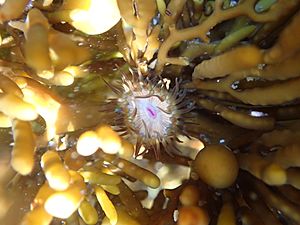Nurse anemone facts for kids
Quick facts for kids Nurse anemone |
|
|---|---|
 |
|
| Scientific classification | |
| Kingdom: | |
| Phylum: | |
| Class: | |
| Order: | |
| Family: |
Hormathiidae
|
| Genus: |
Cricophorus
|
| Species: |
C. nutrix
|
| Binomial name | |
| Cricophorus nutrix (Stuckey, 1909)
|
|
The brooding anemone (scientific name: Cricophorus nutrix) is a special type of sea anemone. It's also called the nurse anemone. This amazing creature only lives in New Zealand.
You can find these anemones living together in groups, called colonies. They often attach themselves to the stems of big seaweeds and kelp. They like to live where the ocean meets the land, in an area called the Intertidal zone. Sometimes, you can also spot them in deep tide pools where there's lots of seaweed.
What Does It Look Like?
This anemone is quite small. It usually measures about 10 to 15 millimetres across. That's about the size of your fingernail! It comes in many different colours. Sometimes, its colours can even seem to shimmer, like a rainbow. This is called iridescence.
Tentacles and Disc
When the brooding anemone is underwater, it stretches out its short, thin tentacles. These tentacles are smooth and have rounded tips. They are usually 2 to 5 millimetres long. The tentacles grow in three or four close circles around the edge of its body. The tentacles closer to its mouth can be twice as long as the outer ones.
The tentacles can be light yellow to deep brown. They often have hints of green, blue, or red. The central part of the anemone, called the disc, can match the tentacles. Or, it might be a different colour like white, purple, or orange. The disc often has lines that spread out from the middle.
Mouth and Body
The anemone's mouth is usually a bright colour. It can be light blue, bright pink, or purple. The inside of its mouth is often a lighter shade. The main body of the anemone, called the column, is usually deep brown. But it can also be green, blue, or yellow.
When the anemone is out of the water, it pulls its tentacles in. This helps it to blend in with the seaweed it's attached to. It's like a natural camouflage!
How Does It Behave?
The brooding anemone has a cool way to protect itself. If something bothers it, it releases long, white threads. These threads are full of stinging cells. This is its way of telling attackers to stay away. It's a defense mechanism to keep itself safe from danger.

